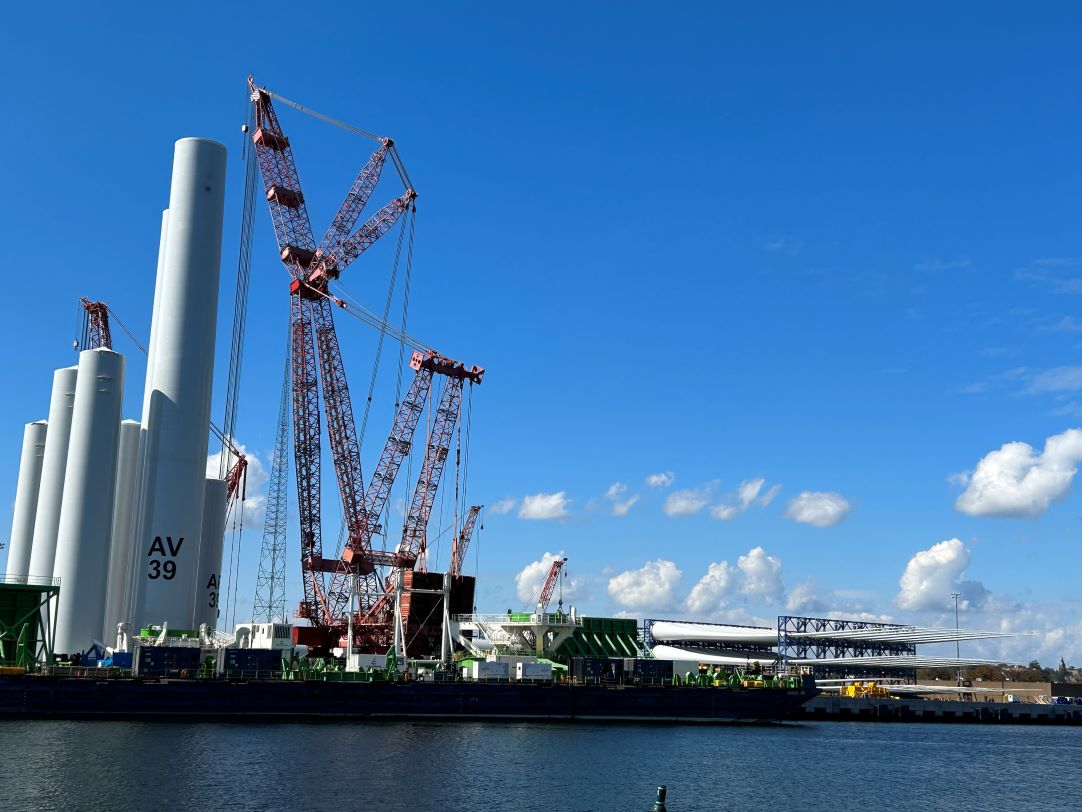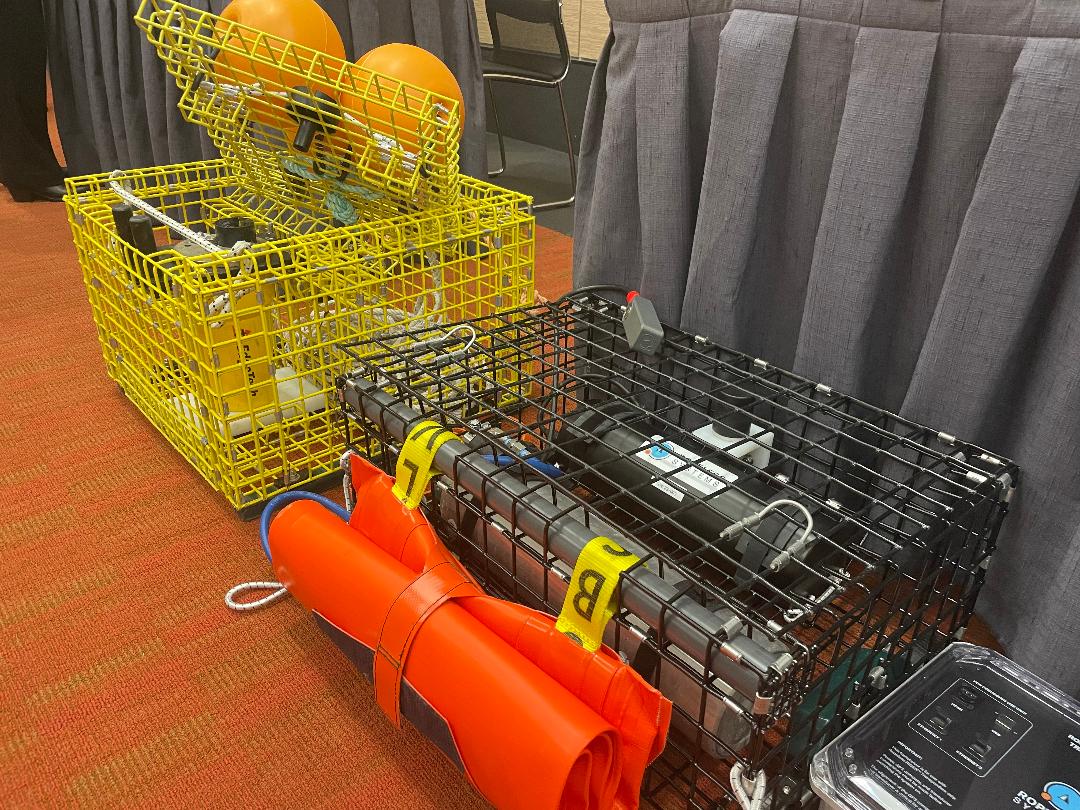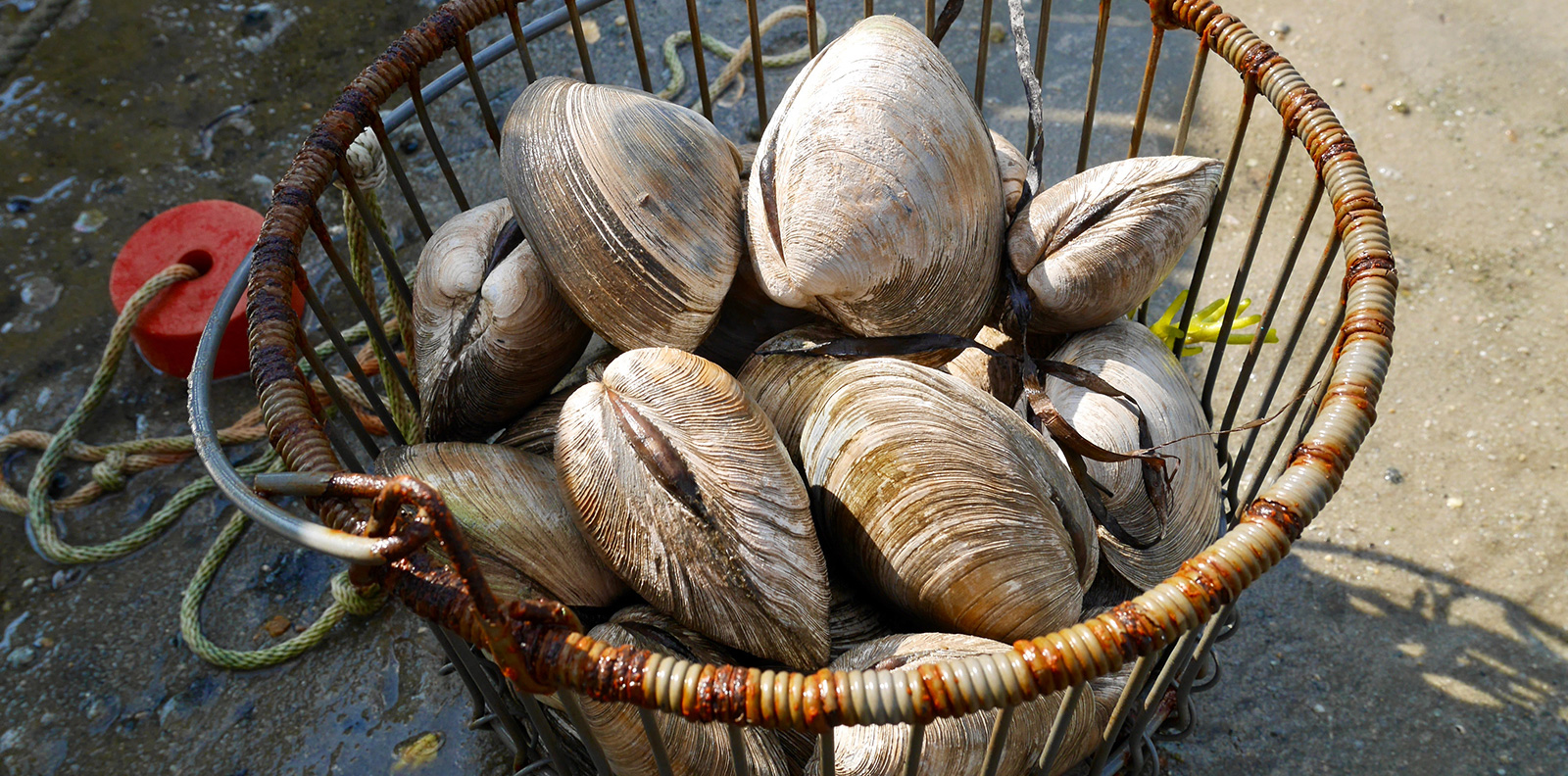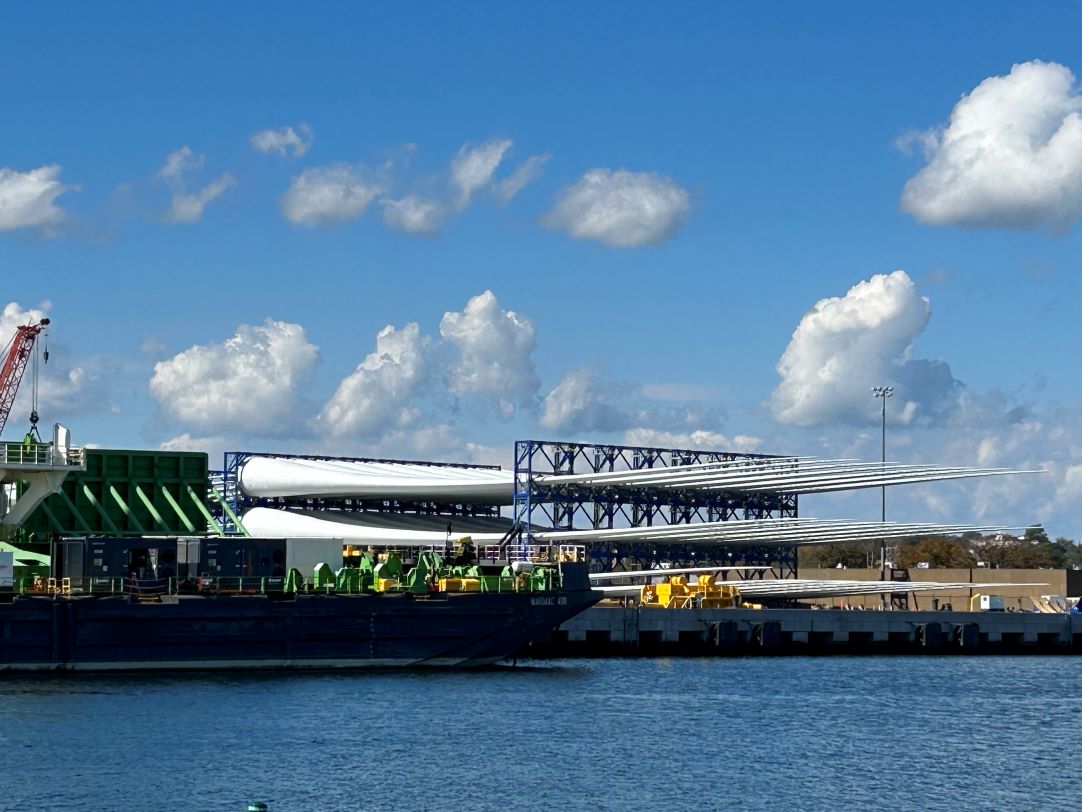Fishermen See Offshore Wind Coming and Buckle Down to Plan for Shared Future
November 9, 2023
The Pulitzer Center supported this story through its Connected Coastlines project.
Offshore wind turbines have a toehold in the Atlantic off the New England coast and, despite some recent retrenchment in the industry due to rising costs and supply chain problems, the safe bet is that more turbines are coming. Most Rhode Island commercial fishermen deeply dislike the prospect, even as a subset of people in the fishing industry has started planning to share the ocean with the three-armed giants.
“We need to find alternative ways to fish so that we don’t end up with Point Judith as a ghost town,” said Fred Mattera, executive director of the Commercial Fisheries Center of Rhode Island.
Some fishermen’s groups are going farther than exploring new gear and techniques for fishing among offshore wind. These groups are examining the carbon footprint of their industry and trying to envision a future of less diesel fuel, less carbon exhaust, and greener technology, on the water and on the shore. They say they are doing this not to undermine wind power, but because of a responsibility to the environment.
Rhode Island fisherwoman Sarah Schumann, who is organizing an industry-wide decarbonization project, said, “If anyone should be free to be activists for decarbonization, the fishing industry should be because we are one of the most climate-impacted industries that there is.”
Even as many fishermen/women continue to grumble about offshore wind and their conviction that the impacts on the ocean environment have not been properly studied, fishing groups in the Ocean State and neighboring Massachusetts and Connecticut are turning their sights to the future.
The Commercial Fisheries Center of Rhode Island, working with the R.I.-based Commercial Fisheries Research Foundation, has invited and hosted experts from Japan who demonstrated fishing techniques that make trawling and other processes much more compact and efficient.
Waterford, Conn., is the home base of the 3-year-old Sea Services North America, a company that trains fishermen, using their own boats, to provide scouting and safety support for offshore wind vessels.
The Port of New Bedford — calling itself “the nation’s number-one fishing port in terms of value of catch” — is developing a new marine terminal and overseeing three more new or expanding terminals that will service both the offshore wind and fishing industries. The new Shoreline Marine Terminal is being developed by the Quinn family, an old Massachusetts fishing family, jointly with two offshore wind developers. The terminal will serve fishing vessels and crew transfer vessels for OSW developments, such as Vineyard Wind I, which is being built now from staging areas in the port.
The Gloucester (Mass) Fishermen’s Wives Development Program recently landed a four-year, $2 million congressional earmark grant to create the Energy Efficient Fisheries project. The project has hired a maritime consultant from Maine, and it is beginning to take a magnifying glass to every on-water and onshore component of the industry to find ways to modernize and decarbonize.
Rhode Island fisherwoman Sarah Schumann has created a project, Fishery Friendly Climate Action (FFCA), to research the fishing and seafood industries and identify ways to guide the industries into a low-carbon future. With a slogan, “Climate action led by people in boots, not people in suits,” FFCA is reaching to the West Coast and Alaska to learn about needs and pilot projects underway across the country. Similar work is being done by the Responsible Offshore Development Alliance (RODA).
Clotheslines? Jigs? Slinky?
Mattera, of the Commercial Fisheries Center, has been fishing out of Point Judith for 40 years. He said about 50-60 boats dock at Point Judith and fish for squid, the port’s major catch. Squid are caught by dragging, or trawling, the seafloor, which is a big worry for fishermen who fear snagging their gear on undersea wind-farm cables.
The footprint for Vineyard Wind I and Revolution Wind, to be built out of Rhode Island ports, is turbines in a grid, spaced about 1 nautical mile apart. Dragger fishermen say that spacing is not big enough. Draggers mostly travel diagonally through a wind-farm area, thereby tightening margins, Mattera said. Captains want to stay a quarter-mile from turbines they pass, for safety; they have to avoid other fishing boats and boats using fixed gear, such as ropes for lobster and crab pots; and they have to bypass “hangs,” which are seafloor obstructions like boulders and wrecks.
“You can see how things get congested quickly,” Mattera said.
Enter here a delegation of Japanese builders and masters of automatic squid jigging machines, who were invited by the Commercial Fisheries Center to Rhode Island for a demonstration. Mattera describes a squid jigger as similar to an old-fashioned pulley clothesline that drops vertically into the water. On the line every few feet is a colorful jig with eight to 10 barbs. The “Marine Fisheries Review” writes, “Squid, attacking the moving jigs, ensnare their tentacles on the hooks. The jigs shift to a horizontal position when reeled aboard, and thus the squid readily become disengaged.” The work is done in the dark, with bright lights to attract the squid. The end game: squid jigging could eliminate the need for onerous and dangerous dragging.
Mattera said the Japanese squid jigger producer Hamade offered the use of four of the devices at no charge for testing in Rhode Island.
Another Japanese technique that Mattera and his colleagues are learning about, called ikejime, leads to catches of low volume and high value, because the fish meat stays fresh for far longer than is typical in the American seafood industry. (Generally, “fishing industry” refers to work on the boats; “seafood industry” refers to onshore processing.)
In the ikejime method, fish are harvested alive and killed quickly with a spike in the brain. Right away, they are cut and drained of blood, and a wire is inserted along their spine. The result of this fast work is that the buildup of lactic acid in the flesh is shut down immediately. The result, Mattera said, is a pearly white — and high-value — meat with a shelf life of seven to 10 days rather than the normal two to three.
A third technique that Rhode Island fisherman are exploring, Mattera said, is slinky pots. They are lightweight and collapsible pots that stack easily on deck and allow work to be done by fewer fishermen. In Alaska, slinky pots have helped to save the black cod fishery, allowing it to move away from hooks, a method that was, in effect, feeding whales and bankrupting fishermen.
Tapping on-water wisdom
Sea Services North America, in Waterford, Conn., was founded in 2019-20 by a lawyer and two fishermen who determined that providing on-water services to offshore wind developers was a smart way for fishermen to diversify their income.
SSNA co-founder and CEO Gordon Videll said that five years ago, wind developers were shuttling “dock to dock” to find boats and crews to provide support for survey vessels. Surveying is done years in advance of permitting and start of construction of any wind project.
“Our group was the first to say, ‘This is coming our way; maybe we can co-exist,’” he said.
The founders did some research in Europe; learned about the high-level skills that are taught and used there, particularly for safety procedures; and founded the company that trains fishermen to do the work. Scout work generally means moving ahead of wind-farm survey vessels to watch for fishing gear and marine mammals. Safety work involves oversight of power export cables that may lie on the seafloor for some time before they are eventually buried. During construction, safety boats move around turbines to keep other boats from danger.
In addition to training 60 fishermen, so far, the company obtains and holds contracts with the wind developers on one hand and the fishermen on the other to provide services. Videll said the company has paid out millions of dollars from developers to fishermen in the past three years, working with fishermen in five coastal states from Massachusetts to New Jersey.
He emphasized that the wind industry work is supplemental income for fishermen, not intended to replace their primary industry. “We give them commercial opportunities to participate and co-exist with any activities that require scouting and safety boats,” Videll said.
At a meeting in August of Rhode Island’s Coastal Resources Management Council pertaining to permissions for Sunrise Wind, Gary Yerman, one of the three co-founders of the company, said SSNA’s partnership with wind developers is positive. “We will be present at the table, and we will work the waters with offshore wind,” he said. “This is not a zero-sum game. It can be a win-win.”
Call me Ishmael
A trip along MacArthur Drive, the frontal road flanking the Port of New Bedford, is a total immersion in giant structures — buildings, cranes, docks — of the fishing and seafood industries, working cheek-to-cheek on a crowded waterfront. It looks tough and industrious and busy, but a slice of the ultra-modern is visible at one terminal, where glossy, white, wing-like wind turbine blades — each as long as a football field — are stacked in huge racks, visitors from the future.

New Bedford’s relationship to the sea is profound, from its history as a global whaling port and Ishmael’s departure on the fictional Pequot of “Moby Dick” to its current fishing and seafood industries, which, said port spokesperson John Regan, employs 6,800 people and generates a total economic impact of $11 billion a year, or 2% of the Massachusetts gross domestic product.
The port’s New Bedford Marine Commerce Terminal, completed in 2014-15, and improved from substantial state investment, was intended as a launch pad for Cape Wind, the wind project proposed for Nantucket Sound, which was defeated by local opposition for the final time in 2017. Unused for a while, the terminal is now managed by the Massachusetts Clean Energy Center and under lease by Vineyard Wind.
When Vineyard Wind I, now constructing the first of 62 turbines on the Outer Continental Shelf, got its final federal permit in 2021, the Port of New Bedford had “the only purpose-built offshore wind terminal in the United States,” said Gordon Carr, executive director of the port.
Three more terminals, including a new one by the port authority and two more that are private projects — one of those by the Quinn fishing family — are under construction or expansion on the New Bedford waterfront. In all, more than $200 million in commercial makeover work is happening now at the port.
Despite the presence of and excitement for offshore wind happening in and through New Bedford, port officials strongly emphasize their support for the city’s historic industry: fishing. In a statement, the port authority declared that it “believes there is room for both industries to thrive without replacing one with the other.”
“A lot of legitimate concerns [by fishermen] are rooted in unknowns of what the impact may be to the ecosystem and the ability to fish around the wind energy area,” Carr said. “There needs to be much more research and analysis of what the impacts are likely to be.”
Regan, the port spokesperson, added that research on impacts “needs to be done on a collective level, not project by project. We need to understand the cumulative impacts.” Carr added that “research has to be for the 30-year life of the project, not just for the construction part of it.”
Carr and Regan pointed to the Synthesis of Science report issued by NOAA in March. The report aims to summarize what is and isn’t known at present about the impacts on the ocean and fisheries from offshore wind. Carr called the report “enlightening and sobering.”
“No port in the United States has more at stake on getting that balance right,” Carr said. He noted that the federal government emphasizes a quartet of responses to harms caused by offshore wind: avoid, minimize, mitigate, compensate. “We need much more effort on ‘avoid’ and ‘minimize.’ Sacrificing one industry in favor of another should not be a choice.”
Even as Carr and Regen were speaking in their office one mid-week day recently, New Bedford scallop fisherman Keith Uzzell was heading up a small demonstration at the harbor front. Uzzell’s position was “We want it all to stop; we don’t want any more of this turbine business in our waters.”
Fisherman Warren Tavares said, “They should find another place to put them [turbines]. I’d like to see them switch over to solar.”
Only a handful of people marched at Uzzell’s demonstration on the first day, but in the space of a half-hour many passing drivers on MacArthur Drive honked their support.
A New Bedford player with a foot in both the fishing/seafood and offshore wind industries is Shoreline Offshore, a joint venture of the father-and-son commercial fishing team of Charles and Mike Quinn, along with Avangrid and Copenhagen Infrastructure Partners. Shoreline Offshore’s marine terminal on 14 acres of waterfront land in the upper harbor will include bulkhead, a shipyard, and open laydown space for wind-industry operations. Both the wind industry and fishing boats will be served by new berthing space, vessel repairs, and maintenance. Vineyard Wind provided $750,000 for the project through its Industry Accelerator Fund.
In an announcement by Vineyard Wind in January, Quinn Fisheries president Charles Quinn said, “This project provides the capacity for the offshore wind industry to efficiently utilize the New Bedford Harbor while also ensuring New Bedford’s commercial fishing industry can continue operating … with little to no interruptions. By expanding space … we’re supplying two key components that both industries need, so that both can flourish.”
Jim Kendall, a former fisherman who left the business after an injury, is owner of New Bedford Seafood Consulting. He works for Vineyard Wind as a fishing industry advocate and representative, a role that exists in other offshore wind projects. He said he got cross-industry conversations started between developers and Rhode Island fishermen by making introductions about a decade ago.
“At first it was very difficult to persuade fishermen to [work with wind developers],” Kendall said. “They were seen by their compatriots as selling out. But if you have to live with the devil, you might as well get something from it. A lot of fishermen are working with these wind groups. They have to supplement their income in any way they can.”
Into the future
Kendall is working now with a young Energy Efficient Fisheries project initiated by the Gloucester Fishermen’s Wives Development Program. With a $2 million grant, the project aims to deeply evaluate the workings of the fishing and onshore seafood industries to find ways to make the industries greener and cleaner.
“All of our boats are pretty aged and using non-efficient power and resources. The boats are outdated and have pretty high emissions,” Kendall said. He said one project objective is to design or find better engines or even electric motors for running boats, operating gear, and powering onshore work like processing, ice making, and trucking.
Yet another task is to find grants or other sources of money to allow boat owners to buy the newer engines, not much different from federal subsidies for people to buy electric cars. Otherwise, Kendall said, the cost of modern engines and gear could be “ruinous” for some fishing boat owners.
In an August press release introducing Energy Efficient Fisheries (EFF), development program president Angela Sanfilippo of Gloucester said, “Commercial fishermen have a proud legacy of stewarding the ecosystems off our shores. … Today we continue that tradition by taking the first statewide steps to address our own industry’s carbon footprint.”
The release also noted that fishing boats rely on diesel for fuel, but, despite its effectiveness, diesel combustion “contributes of climate change and ocean acidification.” Both short-term and long-term alternatives to diesel fuel will be studied closely.
The project manager is Noah Oppenheim, a Maine-based consultant on maritime and fisheries issues. He said the goal of the EFF project “is to assess opportunities for fuel-efficient and emissions reductions and advanced propulsion in the fishing and seafood industries in Massachusetts.”
The timing of the work is significant because of the aging of the fishing fleet and the need for upgrades. It is a complicated picture, because different tasks — from driving boats and activating gear to ice making and trucking — have different energy profiles. Marine propulsion, say, “is much more of a niche than refrigeration or trucking,” Oppenheim said.
Electrification of power needs, with a goal of reducing fossil fuel use and carbon emissions, is always a vision out on the horizon, but where and how it can be used in the industry is uncertain. Elimination or reduction of dirty but efficient diesel fuel to power boats is a big nut to crack.
The first few years of the four-year project will be a deep investigation of the current state of technology in boats and onshore, followed by a couple of years and a half-million dollars invested in pilot scale projects. The project is getting technical assistance from the Green Energy Consumers Alliance.
Of course, some of the work of the project will involve chasing money for the industry to use in making energy-efficient changes. Money sources, said Oppenheim, could cover a lot of ground, from the federal Inflation Reduction Act to the older Diesel Emission Reduction Act, to the Greenhouse Gas Reduction Fund and others. A philanthropic angle could possibly create a new market for tax credits for anyone who wants to invest in low-carbon marine propulsion.
“The fishing industry is profoundly affected by climate change and needs to be part of the solution,” Oppenheim said. “This project would be happening with or without offshore wind. Everyone needs to decarbonize.”
Schumann, the Rhode Island fisherwoman, who also fishes in Alaska and understands the industry there, founded FFCA with similar objectives of the EFF project out of Gloucester. Schumann has interviewed 140 fishermen about their techniques, gear, problems, and needs and a starting point to aim at solutions, including the possibility of electric or hybrid power sources.
She sees the work as her industry’s part in a global task and responsibility.
“We take it as a given that society will come off of fossil fuels,” Schumann said. “We want to provide guidance to fishermen. We should all be focusing on what is the best way to do this. If we don’t do it together, I don’t think it is going to stick.”



